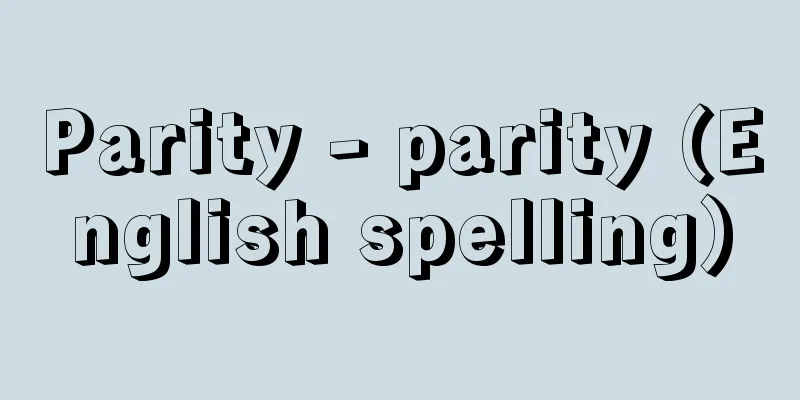Parity - parity (English spelling)

|
A property of particles in quantum mechanics. A symmetry of wave functions, also called even-odd or invertibility. If a quantum mechanical state has the property that its sign does not change by spatial inversion, the state is said to have even (or positive) parity, and if its sign changes, it is said to have odd (negative) parity. Since spatial inversion is a transformation that changes the sign of spatial coordinates twice to return to the original state, there are only two types of parity, positive or negative, which are eigenvalues of the spatial inversion operator. The state of an atom is a state with a fixed parity, even or odd, because the electromagnetic interaction that determines it preserves parity. The nuclear force that forms an atomic nucleus is a strong interaction that preserves parity, so the state of an atomic nucleus can also be said to be a state with a fixed parity. Weak interactions that do not preserve parity slightly (with a probability of less than one in a million) mix components with different parities, but in normal cases where this tiny component is not an issue, it can be considered an eigenstate of parity. As an example, if we consider the shell model state of atoms or atomic nuclei, the parity of a single particle state is expressed as (-1) l if the orbital angular momentum is l ħ (ħ is the Planck constant h divided by 2π), and is therefore determined by whether l is even or odd. A state that contains an odd number of particles with an odd l has odd parity, and in other cases the parity is even. In the general case, this particle state can be read as an internal relative motion state. In other words, the parity of the entire system is given by the product of the parities of all the internal relative motion states. In the case of elementary particles, unlike atoms and atomic nuclei where the number of electrons and nucleons does not change, there is interconversion of elementary particles, so in addition to the parity of the orbital motion, the intrinsic parity of the elementary particles themselves is also considered. If a particle that behaves like an elementary particle can be considered as a composite particle, it is the same as in the case of a multi-particle system. However, ordinary mesons, which can be considered as a two-body bonded system of a quark and an antiquark, have an intrinsic parity that is opposite to the parity of the orbital motion because the parity of the particle and the antiparticle are relatively opposite. For example, mesons (π (pi), η (eta), ρ (rho), ω (omega)), which can be considered as a bonded system of relative S waves, have negative intrinsic parity. The intrinsic parity of the photon is also negative. In the process of parity conservation, the parity of the initial state and the final state (the product of the intrinsic parity of the elementary particles existing and the parity of the relative motion) is equal. In the case of baryons, which are fermions, only the relative parity value between two baryons is meaningful. Since there are as many arbitrary values as there are conservation laws (number of heavy particles, charge, strangeness), in order to describe the matter as naturally as possible, the intrinsic parity of protons, neutrons, and Λ (lambda) particles is usually specified as positive, and the parity of the elementary particles involved is determined using the parity conservation law. Since leptons are involved in weak interactions that violate parity conservation, it is not meaningful to specify an intrinsic parity for leptons. In transitions between states of particles or particle systems with fixed parity, a selection rule is established in which a change in parity occurs (does not occur) corresponding to the operator representing the action that causes the transition changing (does not change) sign by spatial inversion. Parity is conserved in the strong interaction and electromagnetic interaction, but the parity conservation law does not hold in the weak interaction. The non-conservation of parity in weak interactions was first proposed theoretically by T. D. Lee (1926- ) and C. N. Yang (1922- ) in connection with research on the decay of the K meson, and was confirmed in 1957 by C. S. Wu (1912-1997) in the beta decay of the cobalt-60 nucleus. [Ryozo Tamagaki and Tsuneo Uematsu] Source: Shogakukan Encyclopedia Nipponica About Encyclopedia Nipponica Information | Legend |
|
量子力学において粒子のもつ属性の一つ。波動関数の対称性の一つで、偶奇性、反転性ともよび、量子力学的状態が空間反転によって符号が変わらない性質をもつ場合、この状態は偶(または正)のパリティをもつといい、符号が変わる場合は奇(負)のパリティをもつという。空間反転は空間座標の符号を変える変換を二度繰り返すと元に戻るので、空間反転演算子の固有値であるパリティは正か負の2種しかない。原子の状態は、それを決定する電磁相互作用がパリティを保存するので、偶または奇の定まったパリティをもった状態である。原子核を形成する核力はパリティを保存する強い相互作用なので、原子核の状態も定まったパリティの状態といえる。パリティを保存しない弱い相互作用が、パリティの異なった成分をわずかに(100万分の1以下の確率で)混在させるが、この微小成分を問題にしない通常の場合には、パリティの固有状態と考えてよい。例として原子や原子核の殻模型的状態を考えると、一粒子状態のパリティは軌道角運動量をlħ(ħは、プランク定数hを2πで割ったもの)とすると、(-1)lで表されるので、lの偶・奇で決まる。奇数のlをもつ粒子が奇数個含まれる状態は奇のパリティをもち、その他の場合には偶のパリティとなる。一般の場合には、この粒子状態を内部相対運動状態と読み替えればよい。すなわち、全系のパリティは、すべての内部相対運動状態のパリティの積で与えられる。 素粒子の場合には、電子や核子の個数が変わらない原子や原子核の場合と異なり素粒子の相互転化があるので、軌道運動のパリティに加えて、素粒子自身の固有パリティもあわせて考える。素粒子のようにふるまう粒子でも複合粒子とみなせる場合は、多粒子系の場合と同様である。ただし、クォークと反クォークの二体結合系とみなせる通常の中間子は、粒子と反粒子のパリティが相対的に逆であるので、軌道運動のパリティと逆の固有パリティをもつ。たとえば、相対S波の結合系とみなせる中間子(π(パイ)、η(エータ)、ρ(ロー)、ω(オメガ))は負の固有パリティをもつ。また光子の固有パリティは負である。パリティ保存の過程では、始状態と終状態のパリティ(存在する素粒子の固有パリティと相対運動のパリティの積)は等しい。フェルミ粒子であるバリオンの場合には、2個のバリオン間では相対的なパリティの値のみが意味をもつ。保存則(重粒子数、電荷、ストレンジネス)の数だけ任意性があるので、なるべく物理的に自然な記述になるように、通常は陽子、中性子、Λ(ラムダ)粒子の固有パリティを正と指定し、パリティ保存則を用いて関与する素粒子のパリティを決める。レプトンが関与するのはパリティ保存を破る弱い相互作用なので、レプトンに固有パリティを指定するのは有意でない。パリティの定まった粒子または粒子系の状態の間の遷移では、遷移を引き起こす作用を表す演算子が空間反転で符号を変える(変えない)場合に対応して、パリティの変化がおこる(おこらない)という選択則が成立する。強い相互作用および電磁相互作用ではパリティは保存するが、弱い相互作用ではパリティの保存則が成立しない。弱い相互作用でのパリティ非保存は、K中間子の崩壊に関する研究が契機となって、理論的にT・D・リー(1926― )とC・N・ヤン(1922― )によって提唱され、1957年にコバルト60の原子核のβ(ベータ)崩壊でC・S・ウー(1912―1997)によって確認された。 [玉垣良三・植松恒夫] 出典 小学館 日本大百科全書(ニッポニカ)日本大百科全書(ニッポニカ)について 情報 | 凡例 |
>>: Barilla's Revolt - Barilla's Revolt
Recommend
Amida's repentance - Amidakeka
...When these Buddhist methods of repentance were...
Osaka Castle Wall Inscription
This refers to the jointly signed article by the T...
Compander - Ashinki
⇒Compander Source: About Shogakukan Digital Daijis...
Kyoto Conference of Scientists - KAGAKUSHAKYOU KAIGI
As a Japanese version of the Pugwash Conferences, ...
Tsurugaoka Hachimangu Shrine
It is located in Yukinoshita, Kamakura, Kanagawa ...
Public Health Center - Hokenjo
Public health centers are public institutions tha...
Cyclarhis
...General term for birds of the Vireonidae famil...
Habitual dislocation - Habitual dislocation
This refers to a joint that is easily dislocated b...
Related clans - Shinpan
One of the classifications of daimyo established ...
Gertrud von Nivelles
...Agatha was tortured and then burned to death, ...
Ootaru mawashi - Ootaru mawashi
...It is widely distributed in the seas near Japa...
Invertebrates - Invertebrates
The animal kingdom is conveniently divided into t...
Archenteron
The cavity surrounded by the inner layer of the ga...
Soga Festival
During the Edo period, this was one of the annual ...
Ophthalmomaxillary brown-blue nevus - Ganjogakukasseishokubohan
…Those found on the face and limbs are called ect...









